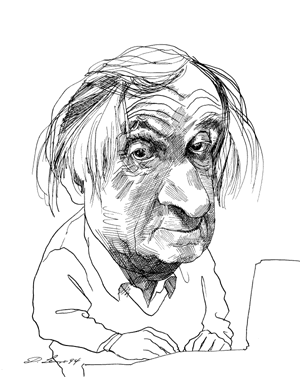It was a dark and stormy night,
The brigands were on the
mountain,
And the chief brigand said:
“Alfonso, tell us a story,”
And the story went as follows:
“It was a dark and stormy
night…”
This is the pattern of The Following Story by the Dutch writer Cees Nooteboom. He specializes in very short, enigmatic, metaphysical novels. This latest one is so beguiling to read that it convinces one, straight off, that at any rate the translator, Ina Rilke, must have got everything right. When the book appeared in the UK at the beginning of the year, the word “elegiac” figured in many of the reviews it got. They were nearly all favorable; and sometimes reproachful as well, rebuking the reading public for having neglected a remarkable writer. Nooteboom’s work is well thought of in Europe (especially in German-speaking countries) and The Following Story won the Aristeion Literature Prize.
Its peculiar appeal is foreshadowed in the epigraph by Theodor Adorno, which begins: “Modesty hesitates to express metaphysical concepts directly.” Nooteboom’s epigraphs are a polyglot liberal education in themselves, and clues to his self-deprecatory writing personality as well. Rituals, for instance, is preceded by Stendhal:
Personne n’est, au fond, plus tolérant que moi. Je vois des raisons pour soutenir tous les opinions; ce n’est pas que les miennes ne soient fort tranchées, mais je conçois comment un homme qui a vécu dans des circonstances contraires aux miennes a aussi des idées contraires.1
Straight after this, and introducing the first section of the novel, comes Theodor Fontane: “Und allen Plänen gegenüber begleitet mich die Frage: ‘Was soll der Unsinn?’; eine Frage, die überhaupt ganz und gar von mir Besitz zu nehmen droht.”2 In the Dutch Mountains starts even more diffidently with a quotation from Hans Christian Andersen: ” ‘Where did we get the story from?’ ‘Out of the dustbin, with all that old rubbish.’ ” Modesty, tolerance, diffidence shading into cheerful despair are disarming qualities, and Nooteboom puts them across without losing one iota of their attractiveness. His style is pared down and laid back, quite deceptively casual, because in fact it is up to great set pieces of imaginative descriptive writing: journeys up the Amazon, into space with Voyager, into the past, and into classical mythology. Since the book has only 115 pages, it is obvious, even from this incomplete list of contents, that Nooteboom practices a carefully organized economy. Though generally elegiac of voice, he is very often very funny.
His previous novels have all been fables or parables. This one is a parable too; but it has what the others perhaps lacked, a soul, or at any rate a convincingly described first-person hero with a soul; and that is surely an advance, because a novel’s endearing qualities work best when they’re incarnate. Nooteboom’s hero is not at all heroic; on the contrary: he looks like Socrates, and that is his nickname among the pupils of the school where he teaches classics. He loves the ancient texts, especially Ovid’s Metamorphoses, in which gods, goddesses, and mortals all change their nature. The transformation of matter, the relation between soul and matter, or consciousness and matter, and what happens to them both after death, these are among his and Nooteboom’s preoccupations. In one of the scenes a biology class watches a film of sexton beetles eating a dead rat.
Mother [beetle] takes a bit of puréed rat, the larvae lick the inside of her mouth. Everything is connected with love. Five hours later they are eating by themselves, the next day they are crawling around in the rolled-up cadaver. CAro DAta VERmibus: Flesh given to worms. Latin scholar’s little joke; sorry.
Socrates’ real name—an unfortunate one—is Herman Mussert, the name of a Dutch Quisling during the war. Mussert is a bachelor in his thirties who lives out of cans: “The sensation of the can-opener ripping through metal,” he says, “the unmistakable toc as you pierce the air-tight lid and you get a whiff of the contents, the way it guides itself around the rim and the indescribable sound that goes with it, it is one of the most sensual experiences I know, though in my case that doesn’t mean very much.” His one and only sexual encounter is with the hard-bitten wife of a colleague who tells him he looks “like a schizoid garden gnome from an antique shop.” Maria Zeinstra teaches biology (it is she who shows the dead rat film) and seduces Mussert only in order to be revenged on her husband, who is having an affair with Mussert’s favorite pupil, Lisa. Lisa is killed in a car crash while eloping with the husband. Because of the scandal, all three teachers are sacked, Maria returns to the husband, and they emigrate to Texas. Mussert takes up writing travel guides to make a living. (Nooteboom is himself a travel writer: and also a poet.)
Advertisement
The denouement occurs twenty years before the start of the novel, which, because of the looping form in which it is written, is not really the start, but just page one. The Following Story is not only about mind and matter but also about time and space. During their affair, Mussert and Maria spend a weekend in a Lisbon hotel. On page one Mussert wakes up in the very same room twenty years later, having gone to bed in Amsterdam the night before. “I had waked up with the ridiculous feeling that I might be dead,” and this turns out to be the case, though the reader is not allowed to understand it at once. The tale of extramarital affairs at the high school is intercut with an Outward Bound type of journey across the ocean from Belém in Portugal to Belém in Brazil (another loop) and on up the Amazon, which stands for Lethe. There are five male passengers on board besides Mussert; all of them have died violent deaths, as it turns out. The sixth passenger is a mysterious woman—Death—who gently leads each of them out into the darkness beyond the ship. And out there waiting for Mussert is Lisa, Mussert’s favorite pupil, his Platonic love, whom he has always identified with Socrates’ favorite pupil, Crito, because she alone in all the school had a feeling for the classics.
The Following Story is full of literary allusions. Reviewers have spotted all sorts of resemblances from E.T.A. Hoffmann through Frisch, Nabokov, and Kundera to Gilbert Adair. The time loop, combined with Mussert’s devotion to the perfect diction of Latin, suggests T.S. Eliot’s “Little Gidding,” where
every phrase
and sentence that is right
…is an end and a beginning.
Aphorisms abound: “love is the pastime of the bourgeoisie”; “the world is a never-ending cross-reference”; and so on. It is a philosophical jeu d’esprit, and therefore difficult to describe without making it sound precious and pretentious. But owing to its sly modesty and knock-out charm, this is not at all how it comes across. Besides, it has the great advantage of being just a meditative story and not a sermon of any kind. Mussert reduces a class of dirty-minded teen-agers to silence and tears with his moving version of the death of Socrates—another set piece. But Lisa is furious with him; she rumbles that he does not believe in the immortality of the soul, though he tells the story as though he did. “The point is not immortality,” he explains.
“The point is that we are capable of thinking about immortality….”
“Without our believing in it, you mean?”
“If you ask me, yes. But I’m not very good at this sort of discussion.”
There is no intention in The Following Story to purvey certainties, another reason for liking it.
This Issue
December 1, 1994
-
1
“No one, at bottom, is more tolerant than I am. I see reasons for holding all opinions; it is not that mine are not sharply defined, but I understand how a man who has lived in circumstances contrary to mine also has contrary ideas.”
↩ -
2
“And the question ‘What’s the use of such nonsense?’ accompanies me in the face of every plan I make; a question that threatens to take possession of me entirely.”
↩




